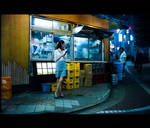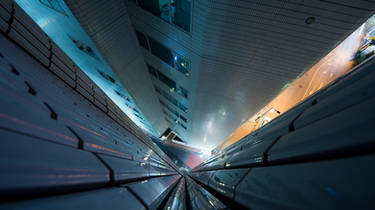Deviation Actions
Literature Text
Have you ever cursed your camera for missing that special moment in the streets? Do you ever struggle to get the subject quickly in focus before the fleeting moment is lost forever in the aether? Well then why not try manual focus? Below is a brief guide to a few key manual focus techniques that can help you capture the decisive moment.
Prime Lenses
Before we can look at the benefits of manual focus, we first have to discuss the use of prime lenses. The reason prime lenses have become a staple of street photographers is simple: speed. Without the need to select a focal length, and forcing yourself to work with one field of view (FOV) you can drastically reduce the time necessary for framing the subject. Of course, the single focal length puts a constraint on what the photographer can do. It also forces us to use our feet. You might think this can slow things down, and zooming would allow you to change perspective more quickly. However, by practicing with the constraint in place, proper positioning becomes second nature. As with the rest of the techniques described in this article, the goal is to make the technique automatic, and therefore, fast.
I don't feel it's necessary to go on with the upsides of prime lenses, since most of you are already converts, or even started out on single focus lenses. So on to manual focusing!
Manual focus, zone focusing, and hyper-focal distance
Manual focus might seem like a daunting prospect, but it is not as difficult as it sounds and it can really open up many possibilities when it comes to street photography. The main advantage of manual focusing over autofocus is speed. Yes, it can be faster to manually focus rather than letting the camera seek focus automatically, regardless of whether you're shooting with a high grade camera body or not (sports photography, certain wildlife photography, etc. are exceptions due to the erratic motion of the subjects). This is especially true in good light because it allows shooting at f/8 or f/11. At small apertures the Depth of Field, or DOF, becomes large. With sharp lenses, one does not need to nail focus exactly on the subject. Even if focus is slightly off, the subject will be sharp due to the large DOF. When using auto-focus, the camera will search for perfect sharpness and then release the shutter.
With practice, one can very quickly guess the approximate best focus with great speed an accuracy. In addition, depending on the auto-focus settings (matrix, spot, etc.) the camera might not focus on the desired point in the frame. The photographer has more control over what should be in focus, and most importantly can make the decision more quickly with manual focus. There's no need to mess around with focus select points and little joysticks on the back of the camera body. Selecting the focus point happens instantly in your mind.
But this isn't the real advantage of using manual focus. Modern AF systems have come a long way, and can nail focus on eyes and faces even in extreme conditions. The real advantage comes with having the focus already setting before you even know what your subject is. Then there is no need to focus at all.
To achieve this, we can use a technique known as zone focusing. We can select a 'zone' between various focus ranges, say between 3 meters and 5 meters. Then you position yourself in such a way as to keep the subject in that range. You can also take advantage of the large DOF at high apertures, such as f/8, and maximize it to the point that no focusing is necessary beyond a certain range.
This is how it's done: all manual focus lenses have a gauge depicting the DOF at small apertures. It will look something like this: 16 — 11 – 8 - | - 8 – 11 — 16. On the focusing ring, the focal distance is depicted in meters (and feet) like this: ∞ 5m 3m 2m 1m .5m .3m. Focus at infinity is marked by ∞. So together the two scales look like this:
For example, at f/8 we can set the focus to place 5m at the left '8' mark, like this:
This gives us a focus zone between 5 meters and 3 meters. That's a pretty big area in which everything will be in sharp focus. You might think it's difficult to consistently place subjects within this range, but you'd be surprised how quickly you can learn the effective focus range of a particular favorite lens. This is also where prime lenses become a key to the techniques. It can be done with a zoom lens, but the varying POV makes it difficult to instantaneously frame the subject as desired, which mitigates the speed advantage of zone focusing.
We can also take this one step further. Say we set the aperture to f/11 and set the focus to place infinity at the left '11' mark, like this:
Now everything from infinity down to ~2 meters will be in focus at f/11. So, as long as we keep the subject more than ~2 meters away from the camera, the subject will always be in focus. In fact, everything beyond ~2m will be in focus. In this way, we have entirely eliminated the need for focusing in bright lightning conditions! This is known as 'hyper-focal distance.'
Of course, we don't always shoot in bright light. Sometimes we need to stop down to f/2 or less. In this case, hyper-focal distance is not a viable option, but zone focusing is still effective. Say you set you focus to 5m at f/2. The zone has become quite small, being only approximately 5 meters. However, by consistently practicing with the same prime lens, you can even learn to shoot from the hip with this technique and get razor sharp results.
Shooting from the hip and quick draw
Once you take advantage of zone focus and hyper-focal distance you can easily draw the viewfinder to your eye, compose, and release the shutter, without taking any time to focus. In addition to this, you can even shoot 'from the hip', that is, without looking through the viewfinder. At first, this might look like a way of simply getting lucky. However, with the assumption that a prime lens is being used, you can learn that particular lens' field of view. With practice, you can predict what will be in the frame without even looking through the viewfinder. This is very difficult to master, and I don't suggest that anyone relies on this technique exclusively. But, I believe it can be a useful tool in your photographic toolbox. Finally, being forced to memorize the lens' field of view, allows for very fast composition and subject placement. In conjunction with zone focusing, this technique allows split second decision making: crucial when capturing the decisive moment!
And this of course is the crux of it all: you want to be absolutely ready to capture the moment without hesitation when it happens. The above techniques, with a lot of targeted practice, can help you do so.
Here are some photos that I took by using these methods. In fact, I feel that I would not have been able to get these these shots had I not used manual focus.
Of course, I understand that manual focus is not for everyone, and not for every situation. But it can be a very useful skill as well as a fun new way to shoot in the streets.

























